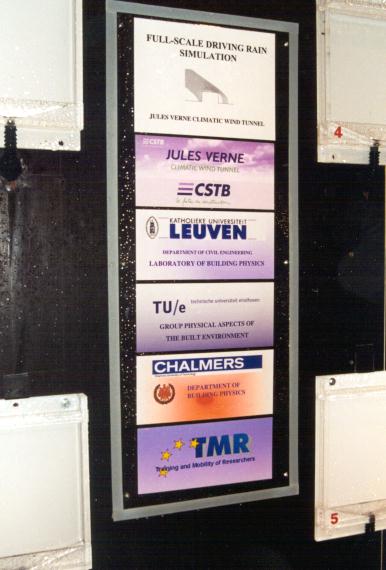Full-scale driving rain simulation in the Jules Verne Climatic Wind Tunnel
A project in the EU programmme Training and mobility of researchers -
Access to large-scale facilities - Access for researchers
31-3-2000 --- 14-4-2000

|
Participating:
- Bert Blocken, Laboratory of Building Physics,
Katholieke Universiteit Leuven, Kasteelpark Arenberg 51,
BE-3001 Heverlee - Leuven,
bert.blocken(à)bwk.kuleuven.ac.be.
- Fabien van Mook, Building Physics group, Technische Universiteit
Eindhoven, Postbus 513, NL-5600 MB Eindhoven,
famo(à)fago.bwk.tue.nl.
- Anneli Högberg/ Carl-Eric Hagentoft,
Department of Building Physics,
Chalmers Tekniska Högskola,
Sven Hultins gata 8, SE-41296 Göteborg,
+46-31-772.19.98,
hagentoft(à)buildphys.chalmers.se.
- Jean-Paul Flori, Jules Verne Climatic Wind Tunnel,
Centre Scientifique et Technique du Bâtiment,
11 rue Henri-Picherit, FR-44323 Nantes Cedex 3,
flori(à)cstb.fr.
|
Photos
... that was the first thing we did of course. The picture shows the test
building (2 x 3 x 2 m) with the (white) driving rain gauges on two sides.
Here is the test section of the wind tunnel:
The wind tunnel was huge, as you can also see from the size of the...
At the wind inlet...
... were placed to generate a wind profile.
The first measurements we did, were wind velocity measurements by ultrasonic
anemometers. We could adapt the building configuration obtaining the following
three configurations:
For the driving rain tests the wind tunnel was equipped by a special...
Rain fall uniformity was tested by a very sophisticated method: buckets.
;-)
We measured rain intensities at ground level by...
And driving rain was measured with 25 driving rain gauges built by
the Catholic University of Louvain:
And we also investigated other driving rain gauges:
And here is a picture which shows the inside of the wall aperture:
The gauges were logged by two computers inside the test house:
But measurements with the standard driving rain gauges were obtained by
weighing the reservoirs manually:
After the measurements were done:
Back to home page http://sts.bwk.tue.nl/drivingrain/.
© 2000-2002 Fabien van Mook/
Fysische Aspekten van de Gebouwde Omgeving
First publication: May 2000.
Last update: 9 December 2002.
